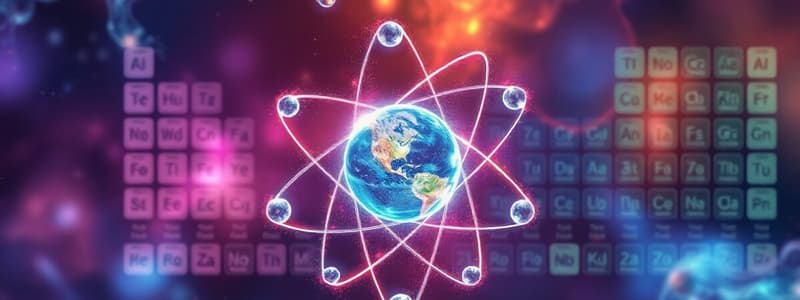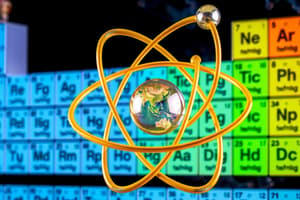Podcast
Questions and Answers
What is the role of protons in an atom?
What is the role of protons in an atom?
- They are responsible for the charge of the atom.
- They define the atomic number of the element. (correct)
- They provide stability to the nucleus.
- They are found orbiting around the nucleus.
What happens to an atom when the number of protons changes?
What happens to an atom when the number of protons changes?
- It gains or loses neutrons.
- It changes into a different element. (correct)
- It loses its charge.
- It becomes an isotope.
Which of the following correctly describes an ion?
Which of the following correctly describes an ion?
- An atom that has lost or gained neutrons.
- An atom with a neutral charge.
- An atom with more protons than electrons.
- An atom that has a charge different from neutral. (correct)
How is the number of neutrons in an atom determined?
How is the number of neutrons in an atom determined?
What type of bond is formed when atoms share electrons?
What type of bond is formed when atoms share electrons?
What is the smallest functional unit of a compound called?
What is the smallest functional unit of a compound called?
What does a pH of 7 represent?
What does a pH of 7 represent?
What is the significance of the pH scale being logarithmic?
What is the significance of the pH scale being logarithmic?
Which of the following accurately describes ionic bonds?
Which of the following accurately describes ionic bonds?
What is the atomic mass of an element?
What is the atomic mass of an element?
Which of the following elements is represented by the symbol 'Au'?
Which of the following elements is represented by the symbol 'Au'?
Which of the following statements about molecules is true?
Which of the following statements about molecules is true?
How many elements are currently known and classified in the periodic table?
How many elements are currently known and classified in the periodic table?
What does pH measure in a solution?
What does pH measure in a solution?
What charge does a neutral atom have?
What charge does a neutral atom have?
What type of bond is represented by the compound NaCl?
What type of bond is represented by the compound NaCl?
What is the relationship between the pH values of 4 and 5?
What is the relationship between the pH values of 4 and 5?
What happens when the number of neutrons in an atom changes but the number of protons remains the same?
What happens when the number of neutrons in an atom changes but the number of protons remains the same?
What process occurs when one atom donates an electron to another atom?
What process occurs when one atom donates an electron to another atom?
Which of the following accurately describes the atomic number of an element?
Which of the following accurately describes the atomic number of an element?
Which of the following compounds is formed by covalent bonds?
Which of the following compounds is formed by covalent bonds?
What characteristic of the pH scale makes a pH of 4 ten times more acidic than a pH of 5?
What characteristic of the pH scale makes a pH of 4 ten times more acidic than a pH of 5?
Flashcards
Element
Element
The simplest form of matter that cannot be broken down into simpler substances.
Atom
Atom
The basic unit of an element, composed of protons, neutrons, and electrons.
Proton
Proton
Positively charged particle found in the atom's nucleus.
Neutron
Neutron
Signup and view all the flashcards
Electron
Electron
Signup and view all the flashcards
Isotope
Isotope
Signup and view all the flashcards
Compound
Compound
Signup and view all the flashcards
pH Scale
pH Scale
Signup and view all the flashcards
Atomic Number
Atomic Number
Signup and view all the flashcards
Atomic Mass
Atomic Mass
Signup and view all the flashcards
Ionic Bond
Ionic Bond
Signup and view all the flashcards
Covalent Bond
Covalent Bond
Signup and view all the flashcards
Molecule
Molecule
Signup and view all the flashcards
Neutral pH
Neutral pH
Signup and view all the flashcards
What makes an isotope radioactive?
What makes an isotope radioactive?
Signup and view all the flashcards
What's the difference between an atom and an ion?
What's the difference between an atom and an ion?
Signup and view all the flashcards
What's the difference between an element and a compound?
What's the difference between an element and a compound?
Signup and view all the flashcards
How do you find the number of neutrons in an atom?
How do you find the number of neutrons in an atom?
Signup and view all the flashcards
What is an isotope?
What is an isotope?
Signup and view all the flashcards
How does the pH scale work?
How does the pH scale work?
Signup and view all the flashcards
Study Notes
Basic Chemistry
- Elements are the simplest form of matter, and cannot be broken down further.
- The periodic table contains 120 known elements, each with a unique symbol. Gold, for example, is Au.
- Atoms are the building blocks of elements.
- Atoms consist of:
- Protons: Positively charged, located in the nucleus.
- Neutrons: No charge, located in the nucleus. Similar size to protons.
- Electrons: Negatively charged, orbiting the nucleus. Extremely small compared to protons/neutrons.
- Atomic Number: The number above the element's symbol. Indicates the total number of protons and, in a stable atom, the number of electrons.
- Atomic Mass: The number below the symbol. Represents the total number of protons and neutrons. To find the number of neutrons, subtract the atomic number from the atomic mass.
- Ions: Atoms with a charge different from zero. Changing the number of electrons changes the charge but not the element.
- Isotopes: Atoms of the same element with different numbers of neutrons. They are usually unstable and radioactive.
- Compounds: Two or more different elements combined. Examples include water (H₂O), carbon dioxide (CO₂), and table salt (NaCl).
- Compounds are held together by:
- Ionic Bonds: One atom donates an electron to another. Example: NaCl (Table salt).
- Covalent Bonds: Atoms share electrons. Example: CH₄ (Methane).
- Molecules: The smallest unit of a compound. For instance, H₂O is a single water molecule.
- pH Scale: Measures the concentration of free hydrogen ions in a solution. It's logarithmic, so each whole number change represents a 10-fold difference.
- A pH of 7 is neutral.
- A pH less than 7 is acidic.
- A pH greater than 7 is basic (alkaline).
Studying That Suits You
Use AI to generate personalized quizzes and flashcards to suit your learning preferences.



